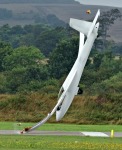[This is the second part of the transcript of my talk at ACCU2016 entitled: “Software Architecture: Living Structure, Art, or Just Hopeful Arrangements of Bytes“]
An enlightening aspect that surprisingly pertains to the issue of software design is the philosophical history that has led us to our current technological society.

Looking back we can see some origins in the Thirty Years War that took place between 1618 and 1648. Some commentators have drawn parallels with the impact of WW1 and WW2 between 1914 and 1945, saying that they could also be seen as a thirty year war. (See the book “Cosmopolis” by Steven Toulmin) The Thirty Years War of 1618 was a terrible war over much of Europe that resulted in the death of a third of the German population. It was a religious war between Protestants and Catholics, i.e. one religion – two factions – and raised serious concerns about the subjectivity of religious faith and the human condition. It was this that brought the quest for certainty to a head. The underlying question was: How can we be certain of what is happening in the world around us? And for the faithful in the 1600s, how can we be certain of God’s plan?
Descartes
It was during this time that René Descartes produced his “Discourse on Method” in 1637. He was the father of analytical geometry and of course coined the famous phrase “I think, therefore I am”. But this was predicated on the fact that we first doubt, thus the more correct phrase should be “I doubt, I think, therefore I am”. He concluded that because of our subjectivity, we cannot trust our senses and what they are telling us about the world, so he returned to the point of doubting. Since there was doubt, there must be a being that is doubting. This being, this ‘I’, that is doubting is thinking about this so therefore I am thinking. Since I am thinking I must exist in order to do that thinking.
Because the church was looking for certainty and because Descartes was able to couch his thought in terms that they could accept, this provided the foundation for the Scientific Revolution. This was followed by the Industrial Revolution which has led us to our current modern technological society. It is interesting to consider the fact that all that we take for granted today represents the end of 300 years or so of work based on Descartes’ philosophical premise: “I doubt, I think, therefore I am” where the aim was to try and eradicate subjectivity.
It is ironic that, although the aim was to be objective, his Cartesian coordinate system can be considered to be based on the structure of the human being! I stand up, and my head could be considered as the Y axis. I stretch my arms out to the side, there you have the X axis. I walk forward and there you have the Z axis.
This points to the difficulties that are implicit in the struggle to eradicate subjectivity – an objective (pun intended!) which I do not consider possible.
Kant
I usually refrain from mentioning Immanuel Kant since I am not a Kanitan scholar, but his thinking has formed much of the basis of modern thought. He produced the “Critique of Pure Reason” in 1781, and there is one quote I wish to highlight here from his considerable body of work. He said that “The world in itself is unknowable”. and this strengthened Descartes’ approach of not trusting our senses. It has given our modern scientific and technological society the excuse to allow our thinking to run ahead of the phenomena of the world.
This activity may sound familiar if you think back to the Path of the Programmer. It is a characteristic of the Journeyman phase.
With regard to my previous workshop on imagination, an area dealing with educating our subjectivity, it is interesting to see that one commentator, Mark Johnson, has noted that Kant had difficulty with imagination – Johnson states that he was “not able to find a unified theory of imagination in Kant’s writings” (The Body in the Mind p166).
Goethe
The third person I want to mention, and the one I feel most drawn to, is Goethe. It was Goethe who raised the warning flag to say that there was a problem with the underlying philosophy and practice of the scientific method. He pointed out that there was too much over-hypothesizing and that the thinking was going ahead of the phenomena of the world. Observation was not being given enough time.
This should ring alarm bells for any programmer because it is exactly what happens when someone takes an undisciplined approach to debugging.
Goethe, however, was particularly interested in understanding the growth of plant life. He wrote the Metamorphosis of Plants in 1788 and identified two very important activities. The first one is Delicate Empiricism (or “Zarte Empirie” in German), i.e. carefully collecting the data, carefully observing the world without overly disturbing its processes.
The second activity, which is what gave me the impetus to give my previous workshop on imagination in 2014, is Exact Sensorial Imagination. This is NOT fantasy, but exact, grounded imagination congruent with the observed phenomena. Goethe was trying to understand how plants grew and how their forms changed during growth.
For me this links to how software projects grow over time, as if they have a life of their own. A programmer needs to have a grasp of how the current software forms may change over time within such a context if they are to minimise future bugs.
The key difference between Descartes and Goethe is that Descartes was trying to eradicate subjectivity whereas Goethe was wanting to educate subjectivity.
The next important phase in philosophical thought is the advent of phenomenology in the 1900s. The realization that the process of coming to know something is crucial to, and as important as, the conclusion. Goethe is not considered a phenomenologist as he focused on specific phenomena rather than the philosophy behind what he was doing, but he definitely prefigured some of their ideas and so could be called a proto-phenomenologist.
We need to understand that phenomenology is a sea-change in philosophical thought. Here we are, living in a modern technological society based on 300 years of progress initiated by Descartes and his subject/object duality, and now the underlying foundational thinking has changed significantly.
The discipline of software development in the forefront of trying to understand what this change of thinking means in practice, though it may not have realised it. We need to understand how we develop our ideas and we need to understand our own cognitive biases, the subject of Dr. Marian Petre’s keynote “Balancing Bias in Software Development“. The point here is that we can do a certain amount in teams but there is also some personal work to do in understanding our own learning processes.
There is a wonderful quote by Jenny Quillien who has written a summary of Christopher Alexander’s Nature of Order books. She says in a preface:
“Wisdom tells us not to remain wedded to the products of thought but to court the process.”
(Jenny Quillien Delight’s Muse)
I think this is a lovely way of putting it. The process needs courting, it has to be done carefully as with Goethe’s Delicate Empiricism.
For those who wish to understand Goethe’s work and the philosophical issues around phenomenology, a primary source is Henri Bortoft. His writing is very understandable, particularly his book “Taking Appearance Seriously” and he draws on the work of Gadamer, one of the more recent phenomenologists.
→ACCU2016: Talk on Software Architecture Design 3: The Issue of Doubt
←ACCU2016: Talk on Software Architecture Design 1: The Path of the Programmer








